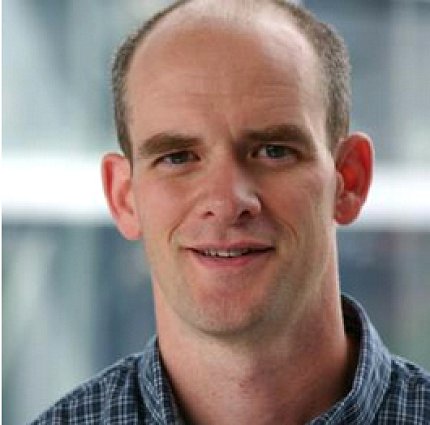Mooney Describes How to Tune Up Tissue Regeneration

Photo: Eliza Grinnell
Regenerative medicine researchers can envision a not-too-distant future when stem cells help to treat periodontal disease, broken jaws, craniofacial defects and more. But first, several challenges must be addressed. For one, it’s not effective to simply inject a mass of stem cells into damaged tissue. Without a physical scaffold to hold cells in place and chemical cues to prompt repair of a defect, stem cells drift away or die.
To address this problem, scientists in the lab of Harvard bioengineering professor Dr. David Mooney design gel-like materials called hydrogels that mimic stem cells’ natural environments. At a recent NIDCR Grand Rounds in Lipsett Amphitheater, Mooney described how hydrogel-encapsulated stem cells can be more precisely controlled, whether grown in the lab or injected into the body.
Years of investigation have shown Mooney’s group that the mechanical properties of a hydrogel—its stiffness or stretchiness—profoundly influence whether bone marrow-derived stem cells (mesenchymal stem cells) develop into fat or bone.
“Mechanical cues can regulate the formation and remodeling of tissues,” said Mooney. “We’re looking at how we can use the mechanics of the substrate to regulate stem cell behavior in the context of regeneration.”
Mimicking the Matrix
In adults, many factors dictate whether stem cells stay on their home turf or move to a site of injury. These instructions come from growth- or healing-related molecules, contact with neighboring cells and attachment to the extracellular matrix, a 3-D fibrous network that supports cells and gives shape to tissues and organs. As stem cells grow, divide and meander, they are in constant contact with the extracellular matrix. Cells inevitably push against the matrix, and like a rubber band, the matrix pushes back.
“Our approach is to try to understand the signals cells receive in their home environments and build them into our biomaterials,” explained Mooney.
Scientists in Mooney’s lab nearly a decade ago wondered if the stiffness of a hydrogel’s matrix—its elasticity—could affect stem cells. The researchers crafted hydrogels using alginate, a complex sugar that gives seaweed its structure and flexibility. Chemical tweaks to the alginate enabled the scientists to adjust hydrogel elasticity and study its effect on cells.
The Mooney group found that mouse and human mesenchymal stem cells grown in softer hydrogels developed into fat-forming cells. In stiffer hydrogels, the cells became bone-forming cells. Hydrogel elasticity also affected the extent of bone regeneration in rat skull defects—medium stiffness worked best. It seemed that matching a hydrogel’s stiffness to that of a given tissue—fat or bone—could nudge cells to form that tissue. The stiffest hydrogels were least effective, perhaps because they were too confining to cells.
“Simply by adjusting the mechanical properties, we can control stem cell behavior and regeneration not only in culture, but also in vivo,” Mooney said.
But elasticity was only part of the story. “Our studies ignored some key aspects of biology,” Mooney said. “When stretched, tissues such as fat, liver and brain don’t snap back into shape like a rubber band. Instead, they have properties between a liquid and a solid—they’re viscoelastic.”
To find out if viscoelasticity affects cells, the Mooney team developed gels with both elastic and viscoelastic features. Such materials initially respond elastically to an applied force. But if that force persists over time, instead of snapping back into shape, viscoelastic materials spread and creep and lose their original shape, similar to modeling clay.
The researchers found that specific levels of both elasticity and viscoelasticity governed whether mesenchymal stem cells grew into bone- or fat-forming cells or healed skull bone defects in rats.
“Our hydrogel is an important tool to study, in a tightly controlled manner, how cell fate is regulated during development, pathology and regeneration,” Mooney said. “This research may also allow us to intervene in new ways by altering the mechanical cues cells receive in order to enhance healing and limit disease progression.”
